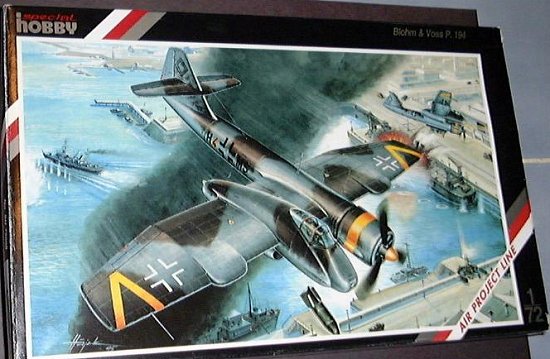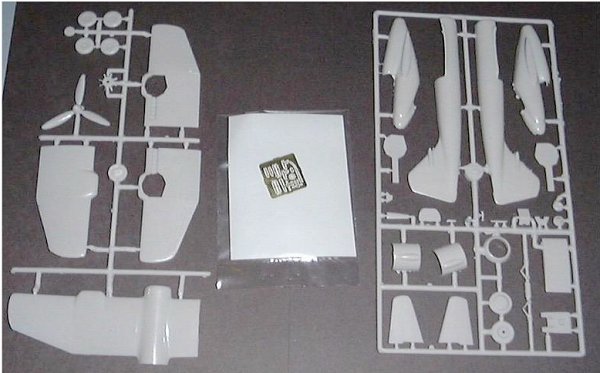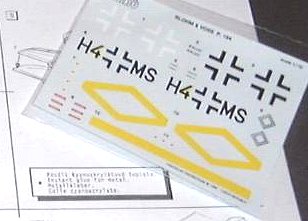
|
KIT: |
Special Hobby 1/72 B&V P.194 |
|
KIT # |
? |
|
PRICE: |
$12.00 MSRP |
|
DECALS: |
see preview |
|
REVIEWER: |
|
|
NOTES: |
Short run with vac and photo etched bits. |

|
HISTORY |
What I can say about the background of this particular aircraft is that it almost certainly was the result of a prank played on the gullible engineers over at Blohm & Voss by either the Focke-Wulf or Arado design teams. Almost without doubt, these rival Gangs of the Slide Rule met at some Brauhaus, and over a heated game of darts and dunkles hefe-weizen, somebody bet the B&V guys that they couldn't make a useable "asymmetric" airframe that would ever see widespread service. Phrases like "wave of the future" and "leading edge" were thrown around. The B&V guys bought it wholesale, and appear to have spent the remainder of the war obsessively pursuing a long and bizzare line of weird looking birds. I won't go through the lineage here, as I'm not all that familiar with it myself. But apparently, they did get one aircraft to the advanced prototype stage as a reconnaissance platform. I'd go look it up to be sure, but there'd be no room for my beer if I go dragging books out, so I'll sally forth without. By the way . . . is it me, or did they change the St Pauli Girl to look like Rebecca Stamos?? I digress.
The B&V 194 was intended to be a low-wing fighter-bomber featuring both a radial piston engine and a jet engine. Knowing the intricacies of tuning ONE engine with multiple carbs, I can't imagine why they wanted to deal with synchronizing power outputs from two completely different power plants. I also can't think of any operational benefit from this arrangement, but maybe one of you Luftwaffe '46 gurus can enlighten me. It is an eye-catcher, 'tis for sure.
|
THE KIT |

I got this model because it was on sale for practically nothing, and I knew that it would at least have some photo-etch in it. For around $4, there wasn't really much to lose. After I got the kit, I did some quick looking online and it appears that there were at least three drawing (or drawring if you're from the Pacific Northwest) board variants of the P. 194. I don't know for sure which one this is, and I also don't know if it's exactly the same as the Revell-Germany kit of the same subject and scale. If this is like some of the WWII experimental project reasearch I did at the Bundesarchiv in Koblenz, then the designs may be open to much interpretation based on the rather conceptual nature of the drawings.
So, being a limited run kit from Eastern Europe, there aren't many surprises here if you keep in mind that the kit appears to be of the older variety. What that means is you get a kit with nice shape and very finely engraved detail. To get to this, you have to work through flash as bad as I've ever seen. In fact, from the look of it, the flash is so extensive that cleaning everything up and getting it all to fit reasonably well will be the bulk of the work for this kit. Not obliterating detail while cleaning it up looks to be a real trick in places. The gates or runners on the sprues are very large and in some very inconvenient places. The pic of the radial engine cooling fan best illustrates this, with two FAT runners going right between the blades. (NOTE TO SCOTT: Insert pic bvsprue here) The plastic is also covered with the usual coat of oily film, but not the used Sam's Choice 20W-50 from ICM. This looks like clean Syntec, so maybe my kit was made after oil change day at the MPM factory. The plastic is brittle, and the runners have snapped off of some wing pieces, leaving me nice, gaping holes to fill.
 As mentioned earlier,
you get one small photo-etch fret consisting mostly of seatbelts, rudder
pedals, and an aerial or two. Sadly, for two separate clear parts you
get ONE vacu-form piece, which means no tolerance for mistakes. You have
to nail this one the first time. The decals are from Propagteam, so no
complaints as far as quality goes. Oddly, the standard concentric square
swastika substitute from the box art made it onto the decal sheet. So,
no swastika and no swastika pieces you can put together, but two little
squares like on the box art. Europa can rest safely knowing there will
be no spontaneous Nazi revival should somebody spot a genuine swastika on
a plastic model. Also, there are markings for just one hypothetical
bird, so the decal demons can't force me to buy more than this one kit I
already have.
As mentioned earlier,
you get one small photo-etch fret consisting mostly of seatbelts, rudder
pedals, and an aerial or two. Sadly, for two separate clear parts you
get ONE vacu-form piece, which means no tolerance for mistakes. You have
to nail this one the first time. The decals are from Propagteam, so no
complaints as far as quality goes. Oddly, the standard concentric square
swastika substitute from the box art made it onto the decal sheet. So,
no swastika and no swastika pieces you can put together, but two little
squares like on the box art. Europa can rest safely knowing there will
be no spontaneous Nazi revival should somebody spot a genuine swastika on
a plastic model. Also, there are markings for just one hypothetical
bird, so the decal demons can't force me to buy more than this one kit I
already have.
The wheels in this kit kind of suck; but they appear to be generic Bf109 wheels, so for a buck or so, a set of resin ones from True Details would really help out. As is usual with some of these kits, there are no locating pins or slots for the wings or tail surfaces, so you'll want to engineer something to align and strengthen the joint considerably. Nothing would be worse than to have a wing crack off your finished bird. The cockpit seat and tub bottom detail is assisted greatly by the small photo-etch sheet. There is NO sidewall detail. This would be very hard to see anyway, but if you were so inclined, a few details could easily be added from scratch. As a last observation, you will have to cut some pieces to have the landing gear in the down position. From the look of the opening, by this point in the war the Germans were having trouble finding an engineer that could design a straight arc for the landing gear. The opening for the wheels looks like a 9-sided polygon instead of being round.
The instrux are a folded one-page affair, but are highly detailed, accurate and leave nothing to be desired. Hobbycraft could learn a LOT from it. There are detailed painting instructions with RLM color call-outs and equivalents in Tamiya, Molak, Agama and Humbrol colors. Oddly, the Tamiya colors are not mixes, but rather straight Tamiya colors, so I would be suspicious of the chart and go with your known favorite source for the RLM colors.
|
CONCLUSIONS |
A good multi-media kit of an interesting Luftwaffe project. In the big scheme of things, the Revell kit is almost certainly more mainstream in kit engineering and therefore MUCH easier to build. However, this kit has P/E, and if you get it on sale for $4, is the way to go. After all, what better way to test and improve your skills than to take on a kit like this from time to time?
Editor's Note: for those who'd like a P.194 without all the hassles that the Special Hobby kit will put you through (after all, it is one of their first models), then I'd highly recommend the Revell of Germany version, assuming you can find one!
If you would like your product reviewed fairly and quickly by a site that has over 200,000 visitors a month, please contact me or see other details in the Note to Contributors.